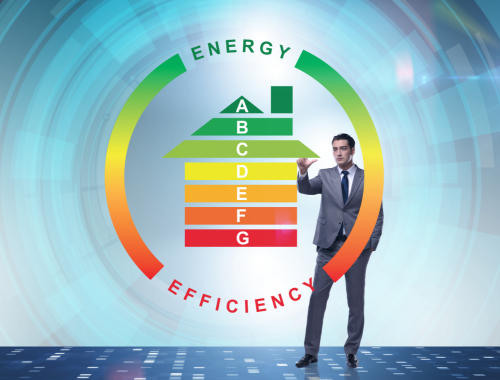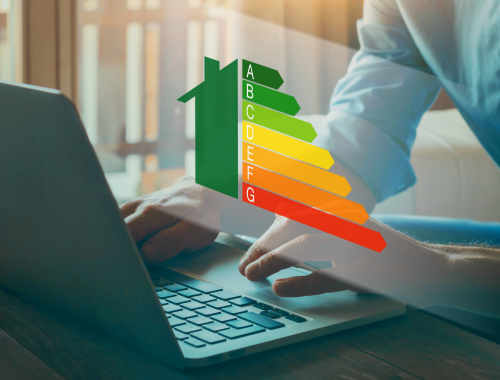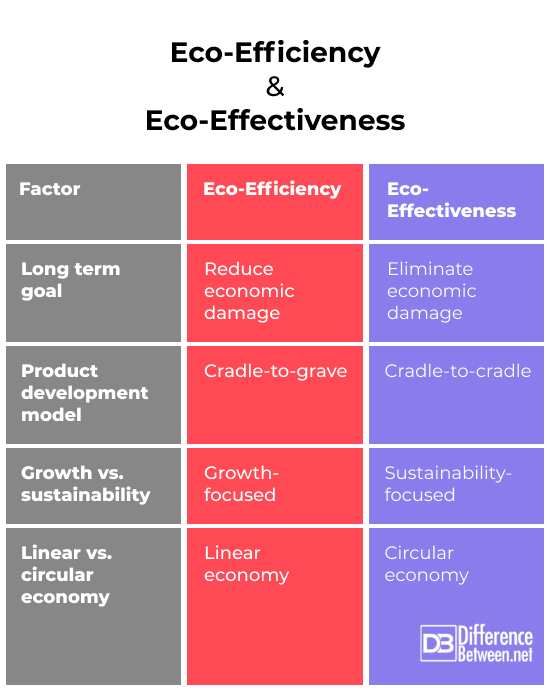Difference Between Eco Efficiency and Eco Effectiveness

Eco-efficiency
What is eco-efficiency in business ethics?
In business ethics, eco-efficiency refers to policies and approaches to production which intend to reduce environmental damage while increasing the production of value. The goals of eco-efficiency are to reduce the extraction of virgin raw materials and water, reduce the energy used in production, and to increase recycling and the use of renewable energy sources. The overall goal of eco-efficiency could be described as decoupling economic growth from environmental damage.
Why is eco-efficiency important?
Eco-efficiency is important in reducing the damaging effects of economic growth on the environment, including pollution and climate change. Healthy ecosystems and balanced biogeochemical cycles are a prerequisite for a flourishing economy, thus reducing damage to the environment by economic production is economically advantageous.
What is the advantage of eco-efficiency?
Eco-efficiency allows for more economic growth and production as it works to decouple economic growth from damage to the environment. If economic growth can be achieved without contributing to the disruption of vital planetary systems, economic growth can sustainably continue. A more efficient use of environmental resources also allows for greater economic productivity and therefore greater financial success for companies that practice eco-efficiency.
Is eco-efficiency the same as sustainability?
Sustainability is a concept which entails creating a process or system that can last for long periods of time without breaking down because of exhausting its resources or causing damage to itself through continued activity. Sustainability is a concept employed by many private companies and in the policies of many nation-states. It differs from eco-efficiency, however, in that sustainability has social as well as environmental dimensions, such as eliminating poverty, whereas the focus of eco-efficiency is mainly on reducing harm to the environment from economic activity, such as production of consumer goods.
What are the factors of eco-efficiency?
Eco-efficiency follows the principles of “reduce, reuse, recycle” to reduce waste and pollution and make resource use more productive. The critical factors in eco-efficiency are the following.
- Reduction in energy use in production.
- Reduction in raw material use in production.
- Increase in recyclability.
- Increase in the durability of products.
- Reduction in the spread of toxic materials.
- Increase in the use of renewable energy and materials.
How is eco-efficiency calculated?
The eco-efficiency of a product or service is calculated by dividing the product or service value by the environmental influence.
What is another term for ecological efficiency?
An early term for what would become eco-efficiency was environmental efficiency, which was first used in the 1970s.

Eco-effectiveness
What is the meaning of eco-effectiveness?
Eco-effectiveness is an approach to the management and production of economic resources that intends to eliminate waste as a concept. Everything is reused, including garbage. Eco-effectiveness applies a cradle-to-cradle methodology, as opposed to cradle-to-grave, to product production. The goal of this model of production is to replicate the efficiency of biological systems where everything is food for something else. When a product can no longer be used, it never becomes waste, but always becomes raw material for a new product.
The principles of cradle-to-cradle production are the following, 1) every waste product is a resource for something else, 2) use renewable and clean energy, and 3) celebrate diversity.
Another concept integral to eco-effectiveness is a circular economy, as opposed to a linear economy. A linear economy is an economy where production involves extraction of material, use of material in making a product, and eventual disposal of the product and its materials when the product’s use-life has expired. This process creates waste that builds up in landfills or that is simply incinerated. In a circular economy, however, products are never discarded as waste. When products are at the end of their use-life, they will always be used as raw materials for new products. This also makes a circular economy self-regenerative rather than parasitic on the natural environment. A circular economy can help prevent both the over-exploitation of natural resources and the buildup of harmful waste in the environment. This is because all materials are circulated within the economy without new material needing to constantly be introduced from the outside or already used material constantly exiting the system as waste. In other words, a circular economy is an economy based on a cradle-to-cradle model of product development.
What is an example of eco-effectiveness?
An example of eco-effectiveness would be the company, SunPower, which manufactures solar panels using a cradle-to-cradle production model. The solar panels produce clean energy and are made of non-hazardous, reusable materials.
Similarities between eco-efficiency and eco-effectiveness
Eco-efficiency and eco-effectiveness are similar in that they both intend to change the way that the economy impacts the environment by reducing or eliminating damage caused to the environment by economic activity. They are also both responses to rising concerns over increasing environmental pollution and anthropogenic climate change, among other modern environmental challenges. In this way, both eco-efficiency and eco-effectiveness are an attempt to incorporate long-term concerns about environmental sustainability into business practices to counterbalance or inform a focus on short-term profits.
Differences between eco-efficiency and eco-effectiveness
What is the difference between eco-efficiency and eco-effectiveness with its cradle-to-cradle production model?
Although the terms are similar, eco-efficiency and eco-effectiveness differ in important ways. These differences include the following.
- Eco-efficiency intends to reduce damage to the environment, whereas eco-effectiveness intends to eliminate damage to the environment entirely.
- Eco-efficiency is an improvement upon a linear economy with a cradle-to-grave approach to product development, whereas eco-effectiveness replaces cradle-to-grave models of product development with the cradle-to-cradle model.
- Eco-efficiency generally remains focused on economic growth while minimizing environmental damage, whereas eco-effectiveness is a shift away from a focus on economic growth and towards a focus on sustainability.
- Eco-efficiency maintains a linear economy, whereas eco-effectiveness introduces a circular economy where resources are always re-used and kept in circulation.
Eco-efficiency vs. Eco-effectiveness

Summary
Eco-efficiency refers to approaches in business and policy which aim to reduce the negative environmental impacts of economic growth while still maintaining increases in economic productivity. Eco-efficiency involves reducing the amount of virgin materials, water, and energy required in production while increasing production and economic growth. Eco-efficiency is distinguished from sustainability in that it does not take into account social concerns, such as eliminating poverty. Eco-effectiveness refers to an approach which seeks to eliminate waste from a system by creating a circular economy where all raw materials and products are re-used and circulated within the production process without the production of waste. In this way, eco-effectiveness seeks to make technology and the economy resemble ecology in which waste materials of one product always become raw materials for a new product. The product lifestyle model for eco-effectiveness is cradle-to-cradle, where a product is manufactured, used, remanufactured, and reused ad infinitum. This contrasts with the cradle-to-grave model where a product is destined to be discarded. Eco-efficiency and eco-effectiveness are similar in that they are both attempts to decouple the economy from environmental damage and both a response to modern problems such as pollution and climate change. They differ in that eco-efficiency is seeks to reduce environmental damage, still has a cradle-to-grave production model, remains growth-focused, and retains a linear economy, while eco-effectiveness seeks to eliminate environmental damage entirely, has a cradle-to-cradle model of product development, is sustainability-focused, and proposes a circular economy.
- Difference Between Environmental Performance Index and Development - November 24, 2023
- Difference Between Environmental Intervention and Development - November 8, 2023
- Difference Between Eco Efficiency and Eco Effectiveness - September 18, 2023
Search DifferenceBetween.net :
Leave a Response
References :
[0]“Eco Efficiency vs Eco Effectiveness.” EcoCation, n.d., https://ecocation.org/eco-efficiency-vs-eco-effectiveness/.
[1]Ichimura, Masakazu, et al. Eco-efficiency Indicators: Measuring Resource-use Efficiency and the Impact of Economic Activities on the Environment, PDF, United Nations, 2009. Available at: https://sustainabledevelopment.un.org/content/documents/785eco.pdf.
[2]Mollenkamp, Daniel Thomas. “What is Sustainability? How Sustainabilities Work, Benefits, and Example.” Investopedia, 8 April 2023, https://www.investopedia.com/terms/s/sustainability.asp#:~:text=In%20the%20broadest%20sense%2C%20sustainability,available%20for%20the%20long%20term.https://mcdonough.com/cradle-to-cradle/, Accessed 3 July 2023.
[3]Pangestu, Mari Elka and Juergen Voegele Juergen. “Investing in nature makes good economic sense.” Voices (World Bank),5 Oct. 2020, https://blogs.worldbank.org/voices/investing-nature-makes-good-economic-sense. Accessed 8 July 2023.
[4]Srinivas, Hari. “Eco-Efficiency.” Sustainable Development Concepts, https://www.gdrc.org/sustdev/concepts/04-e-effi.html#:~:text=Definition,the%20product%20or%20service's%20life. Accessed 3 July 2023.
[5]SunPower. https://us.sunpower.com/products/solar-panels. Accessed 3 July 2023.
[6]United Nations Summit on Biodiversity, PDF, United Nations, 2020. Available at: https://www.un.org/pga/75/wp-content/uploads/sites/100/2020/11/Summary-Biodiversity-Summit-4-November-clearedFINAL-002.pdf.
[7]“What is a Circular Economy?” EcoCation, n.d., https://ecocation.org/what-is-the-circular-economy/.
[8]“What is eco-efficiency? Definition and examples.” Market Business News, n.d., https://marketbusinessnews.com/financial-glossary/eco-efficiency/.
[9]Image credit: https://www.canva.com/photos/MAENc4C9U9U-energy-efficiency-rating-concept-eco-home/
[10]Image credit: https://www.canva.com/photos/MADIYGUi-Ww-businessman-in-energy-efficiency-concept/
